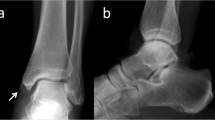Abstract
Painful os peroneum syndrome encompasses a spectrum of disorders associated with lateral foot and ankle pain. In the setting of an os peroneum fracture or diastasis of a partitioned os peroneum, marked displacement of the proximal fragment on radiographs is often used as an imaging surrogate for detection of a complete peroneus longus tendon tear. We present a case of a displaced proximal fragment of the os peroneum above the level of the ankle joint on radiographs and MRI associated with incomplete tear of the peroneus longus tendon. We hypothesize that such an injury pattern results from an anatomic prerequisite where the os peroneum occupies a portion of the cross-sectional diameter of the tendon. We suggest that the retracted proximal moiety of the sesamoid bone is the result of elastic recoil of delaminated fibers of the peroneus longus directly inserting on the os, whereas eccentric bundles of the tendon draping over the os remain in continuity. Although treatment implications are debatable, the case questions the assumption of a complete peroneus longus tear based on a retracted os peroneum on radiography and highlights the role of MRI in providing a full description.







Similar content being viewed by others
References
Sobel M, Pavlov H, Geppert MJ, Thompson FM, DiCarlo EF, Davis WH. Painful os peroneum syndrome: a spectrum of conditions responsible for plantar lateral foot pain. Foot Ankle Int. 1994;15(3):112–24. https://doi.org/10.1177/107110079401500306.
Brigido MK, Fessell DP, Jacobson JA, et al. Radiography and US of os peroneum fractures and associated peroneal tendon injuries: initial experience. Radiology. 2005;237(1):235–41. https://doi.org/10.1148/radiol.2371041067.
Wang XT, Rosenberg ZS, Mechlin MB, Schweitzer ME. Normal variants and diseases of the peroneal tendons and superior peroneal retinaculum: MR imaging features. Radiographics. 2005;25(3):587–602. https://doi.org/10.1148/rg.253045123.
Muehleman C, Williams J, Bareither ML. A radiologic and histologic study of the os peroneum: prevalence, morphology, and relationship to degenerative joint disease of the foot and ankle in a cadaveric sample. Clin Anat. 2009;22(6):747–54.
Benjamin M, Qin S, Ralphs JR. Fibrocartilage associated with human tendons and their pulleys. J Anat. 1995;187(Pt 3):625–33.
Guimerá V, Lafuente A, Zambrana L, Rodriguez-Niedenführ M, Sañudo JR, Vazquez T. The peroneocuboid joint: morphogenesis and anatomical study. J Anat. 2015;226(1):104–12. https://doi.org/10.1111/joa.12249.
Sarrafian SK, Kelikian AS. Sarrafian’s anatomy of the foot and ankle: descriptive, topographic, functional. 3rd ed. Philadelphia: Lippincott Williams & Wilkins; 2011.
Taljanovic MS, Alcala JN, Gimber LH, Rieke JD, Chilvers MM, Latt LD. High-resolution US and MR imaging of peroneal tendon injuries. Radiographics. 2015;35(1):179–99. https://doi.org/10.1148/rg.351130062.
Tehranzadeh J, Stoll DA, Gabriele OM. Case report 271. Posterior migration of the os peroneum of the left foot, indicating a tear of the peroneal tendon. Skeletal Radiol. 1984;12(1):44–7. https://doi.org/10.1007/BF00373176.
Hallinan JTPD, Wang W, Pathria MN, Smitaman E, Huang BK. The peroneus longus muscle and tendon: a review of its anatomy and pathology. Skeletal Radiol. 2019;48(9):1329–44. https://doi.org/10.1007/s00256-019-3168-9.
Peterson DA, Stinson W. Excision of the fractured os peroneum: a report on five patients and review of the literature. Foot Ankle. 1992;13(5):277–81. https://doi.org/10.1177/107110079201300509.
Bashir WA, Lewis S, Cullen N, Connell DA. Os peroneum friction syndrome complicated by sesamoid fatigue fracture: a new radiological diagnosis? Case report and literature review. Skeletal Radiol. 2009;38(2):181–6. https://doi.org/10.1007/s00256-008-0588-3.
Peacock KC, Resnick EJ, Thoder JJ. Fracture of the os peroneum with rupture of the peroneus longus tendon. A case report and review of the literature. Clin Orthop Relat Res. 1986;202:223–6. https://doi.org/10.1097/00003086-198601000-00030.
Favinger JL, Richardson ML, Chew FS. Progressive retraction of a fractured os peroneum suggesting repetitive injury to the peroneus longus tendon. Radiol Case Rep. 2017;13(1):216–9. https://doi.org/10.1016/j.radcr.2017.11.006.
Tawk S, Lecouvet F, Putineanu DC, Acid S. Unusual proximal fragment migration of an os peroneum fracture with associated peroneus longus tendon injury-a tree often hides a forest. Skeletal Radiol. 2019;48(2):317–22. https://doi.org/10.1007/s00256-018-3019-0.
Falkowski AL, Jacobson JA, Hirschmann MT, Kalia V. MR imaging of the quadriceps femoris tendon: distal tear characterization and clinical significance of rupture types. Eur Radiol. 2021;31(10):7674–83. https://doi.org/10.1007/s00330-021-07912-y.
Author information
Authors and Affiliations
Corresponding author
Ethics declarations
Consent to participate
Informed consent was obtained from the subject described in this report.
Conflict of interest
The authors declare no competing interests.
Additional information
Publisher's note
Springer Nature remains neutral with regard to jurisdictional claims in published maps and institutional affiliations.
Rights and permissions
Springer Nature or its licensor (e.g. a society or other partner) holds exclusive rights to this article under a publishing agreement with the author(s) or other rightsholder(s); author self-archiving of the accepted manuscript version of this article is solely governed by the terms of such publishing agreement and applicable law.
About this article
Cite this article
Lee, B., Parellada, A.J. & Gorbachova, T. Retracted os peroneum with partial integrity of the peroneus longus tendon. Skeletal Radiol 53, 179–185 (2024). https://doi.org/10.1007/s00256-023-04407-3
Received:
Revised:
Accepted:
Published:
Issue Date:
DOI: https://doi.org/10.1007/s00256-023-04407-3




